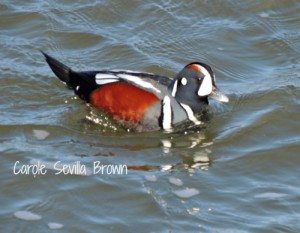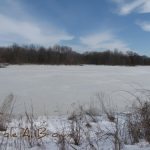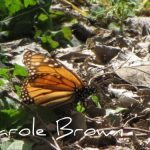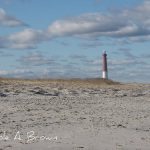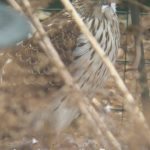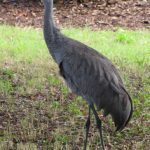This weekend I made my annual trip to Barnegat Light, NJ to see some of the most beautiful ducks in the world who spend the winter months along this jetty. Barnegat Light is located at the northern tip of Long Beach Island, which is just south of where superstorm Sandy made landfall last October.
The prize for taking the long walk on this rock jetty, in 35 mph winds, with waves crashing across the rocks (making the rocks slippery and me quite wet in very chilly weather), with sand and salt spray stinging my face, and knowing that I would have to make the long walk back again, for me is the Harlequin Ducks.
Harlequin Ducks (Histrionicus histrionicus) are small, sea ducks that are found along the coasts of North America and Eurasia. They are named for their distinctive, colorful plumage, which features bold, contrasting patterns of white, black, and rusty brown.
Harlequin Ducks are strong swimmers and divers, and they feed on small invertebrates and fish that they catch underwater. They are well-adapted to life along rocky coasts, where they breed in crevices and on ledges along the shore.
In North America, Harlequin Ducks are found along the Pacific and Atlantic coasts, and their populations are concentrated in Alaska and Canada. The species is listed as a species of special concern in some states, as their populations have declined due to habitat loss, pollution, and other threats.
However, Harlequin Ducks are highly valued by birdwatchers and wildlife enthusiasts, and they are considered a flagship species for the health of coastal ecosystems. The species is also important to indigenous cultures, and is recognized as a symbol of the rugged beauty and diversity of the coastal environment.
To protect Harlequin Ducks and their habitats, conservation organizations and government agencies are working to reduce the impacts of human activities on the species, and to restore and protect critical habitats along the coast. These efforts will help ensure the survival of this remarkable species and the health of the coastal ecosystems they depend on.
I had heard from a friend that Razorbills had been spotted at the Manasquan Inlet the day before, so we left Barnegat, and travelled around to the next barrier island north along the Jersey Coast. I wanted to visit Island Beach State Park on the southern tip of Barnegat Penninsula, and then travel up to the northern tip to see the Razorbills at Manasquan Inlet.
What didn’t occur to me as we attempted to make this drive, is that this barrier island was where superstorm Sandy made landfall, and I was not prepared for the devastation I was going to see here.
More From Ecosystem Gardening:
Submit your review | |

